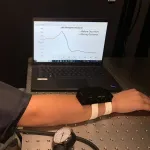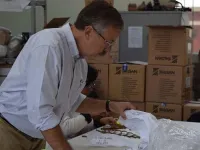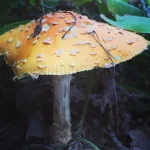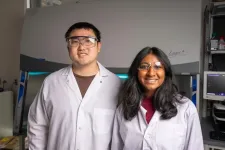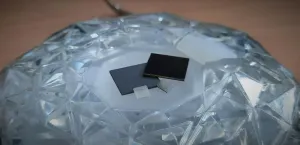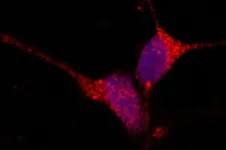(Press-News.org) Imagine if humans could ‘talk’ to plants and warn them of approaching pest attacks or extreme weather.
A team of plant scientists at the Sainsbury Laboratory Cambridge University (SLCU) would like to turn this science fiction into reality using light-based messaging to ‘talk’ to plants.
Early lab experiments with tobacco (Nicotiana benthamiana) have demonstrated that they can activate the plant's natural defence mechanism (immune response) using light as a stimulus (messenger).
Light serves as a universal means of daily human communication, for example the signalling at traffic lights, pedestrian crossings, or the open-closed status of a shop.
Alexander Jones’ research team is using light as a messenger in the development of tools that enable plants to communicate with humans and humans to communicate with plants.
The University of Cambridge team previously engineered a series of biosensors using fluorescent light to visually communicate in real-time what is happening at the cellular level in plants, revealing the dynamics of critical plant hormones. These biosensors can tell us how plants are reacting to environmental stresses – plants ‘talking’ to humans.
Their latest research published in PLOS Biology, describes a new tool called Highlighter, which uses specific light conditions to activate the expression of a target gene in plants, for example to trigger their defence mechanisms – humans ‘talking’ to plants.
The concept of humans being able to communicate with plants on a meaningful level has long captured the imagination of people. If such a capability was possible, it could revolutionise agriculture and our relationship with plants.
“If we could warn plants of an impending disease outbreak or pest attack, plants could then activate their natural defence mechanisms to prevent widespread damage,” Dr Jones said. “We could also inform plants about approaching extreme weather events, such as heatwaves or drought, allowing them to adjust their growth patterns or conserve water. This could lead to more efficient and sustainable farming practices and reduce the need for chemicals.”
Bo Larsen, who engineered Highlighter while at SLCU, has taken us a major step closer to this goal of ‘talking’ to plants by engineering a light-controlled gene expression system (optogenetics system) from a prokaryotic system into a eukaryotic system that is tailored for plants.
Optogenetics can bring light to biomolecular processes in plants
To understand cellular activity biologists need to be able to control biomolecular processes at the cellular level. Optogenetics is a scientific technique that uses a light stimulus to activate or deactivate a specific process. “Light stimuli are cheap, reversible, non-toxic and can be delivered with high-resolution,” Dr Jones said.
To do this, scientists engineer light-sensitive proteins (photoreceptors) to control a target process and then deliver these optogenetic ‘actuators’ to the cells they want to control.
Optogenetics has revolutionised many fields including neuroscience where biologists can isolate functions of individual neurons.
However, optogenetics has been difficult to apply to plants. This is because plants already contain lots of photoreceptors and need a wide spectrum of light to grow. Switching from dark to light also activates native plant photoreceptors and a myriad of cellular systems.
Exacerbating this problem is the fact that many of the best performing optogenetic actuators use genetic parts from plants, meaning they could cross-talk with native photoreceptors if used in plants.
The story behind the research
Dr Jones, looking for an optogenetic gene expression switch that could be applied under normal horticultural light conditions without impacting on endogenous plant physiology and development, sought advice from J. Clark Lagarias, from UC Davis, who is an expert in phytochrome and cyanobacteriochrome light-switches.
He suggested repurposing the prokaryotic CcaS-CcaR optogenetic system, which was originally sourced from photosynthetic microbes and uses the ratio of green (on) - red (off) light signals. By modulating the spectrum of white light plants need to grow, genes could be turned on or off using a minimally invasive stimulus.
But when developing Highlighter into a eukaryotic optogenetic system, Dr Larsen detected an unexpected blue-off behaviour. Could the conversion have altered the green-red spectral properties of the CcaS photoreceptor?
Working together with Alex Jones, Ines Camacho and Richard Clarke from the National Physical Laboratory (NPL), they detected that the new system was still able to use green and red light just like the original system. But the spectroscopic analysis at NPL also showed evidence of an independent blue-light sensing. Co-author Roberto Hofmann noticed that, in addition to the red-green sensing domain, CcaS had a domain with homology to blue-light photosensors called phototropins. It seems the engineering efforts had inadvertently unlocked a latent CcaS blue sensing behaviour, providing an alternate way to control CcaS-CcaR activity.
Highlighter is an optogenetic tool for plants
When deployed in plants, Highlighter uses minimally invasive light signals for activation and inactivation, and is unaffected by the light-dark cycling in growth chambers.
The current Highlighter system is inactive under blue light conditions and active in the dark and under white light, green light and, mysteriously, red light conditions. Further work is planned to progress development of Highlighter, but the team has already demonstrated optogenetic control over plant immunity, pigment production and a yellow fluorescent protein, the latter at cellular resolution.
“Highlighter is an important step forward in the development of optogenetics tools in plants and its high-resolution gene control could be applied to study a large range of fundamental plant biology questions,” Dr Jones added. “A growing toolbox for plants, with diverse optical properties, also opens exciting opportunities for crop improvement. For example, in the future we could use one light condition to trigger an immune response, and then a different light condition to precisely time a particular trait, such as flowering or ripening.”
Reference
Bo Larsen, Roberto Hofmann, Ines S Camacho, Richard W Clarke, J Clark Lagarias, Alex R Jones and Alexander M Jones (2023) Highlighter is an optogenetic actuator for light-mediated, high resolution gene expression control in plants. PLOS Biology.
DOI: https://doi.org/10.1371/journal.pbio.3002303
END
Conversations with plants: Can we provide plants with advance warning of impending dangers?
Imagine if humans could ‘talk’ to plants and pre-warn them of approaching pest attacks or extreme weather.
2023-09-21
ELSE PRESS RELEASES FROM THIS DATE:
Chicago’s West Side is air pollution hotspot
2023-09-21
Three independent state-of-the-art datasets reveal that the West Side has more nitrogen dioxide (NO2) pollution than the rest of the city
Depending on the month, residents in this area experience 16 to 32% higher NO2 concentrations on average
By identifying hotspots, residents and policymakers can be confident about where to prioritize immediate interventions
EVANSTON, Ill. — The western edge of Chicago — including the North and South Lawndale, East Garfield Park, Archer Heights and Brighton Park neighborhoods — experiences up to 32% higher concentrations of nitrogen dioxide (NO2) air pollution compared to the rest of the city, ...
Biophysical Society announces 2024 Society Fellows
2023-09-21
ROCKVILLE, MD – The Biophysical Society is proud to announce its 2024 Society Fellows. This award honors the Society’s distinguished members who have demonstrated excellence in science and contributed to the expansion of the field of biophysics. The Fellows will be honored at the Biophysical Society’s 68th Annual Meeting, being held in Philadelphia, Pennsylvania from February 10-14, 2024. The 2024 Fellows are:
Rommie E. Amaro, University of California, San Diego, USA, is named a Biophysical Society Fellow for her work on developing methods to enable the simulation of biological molecules in situ and ...
Wearable optical device shows promise for detecting postpartum hemorrhage
2023-09-21
WASHINGTON — Researchers have developed a wearable optical device for early detection of hemorrhage during labor or after childbirth. This serious heavy bleeding can be hard to detect before it becomes an emergency and accounts for almost 30% of maternal deaths globally and just over 10% of maternal deaths in the United States.
Studies have shown that early diagnosis and treatment for postpartum hemorrhage is the best way to prevent deaths. The new device is designed to be worn on the wrist, where it uses laser speckle imaging to continuously ...
David Huang, M.D., Ph.D., receives Lasker Award for transformative imaging technology
2023-09-21
PORTLAND, Oregon -- The United States’ most distinguished biomedical research award is being given to Oregon Health & Science University physician-scientist David Huang, M.D., Ph.D., for co-inventing an imaging technology that routinely helps prevent blindness and is increasingly used to diagnose and treat conditions of the heart, brain, skin and more.
Huang is receiving the 2023 Lasker-DeBakey Clinical Medical Research Award as a co-inventor of optical coherence tomography, or OCT, the Albert and ...
New study reveals a long history of violence in ancient hunter-gatherer societies
2023-09-21
Violence was a consistent part of life among ancient communities of hunter-gatherers, according to a new study co-authored by a Tulane University researcher that looked for signs of trauma on 10,000-year-old skeletal remains from burial sites in northern Chile.
The study was published in the journal PLOS ONE.
Archaeological research has shown that interpersonal violence and warfare played an important role in the lives of hunter-gatherer groups over time. Still, many questions remain about the factors that influence such violence. The record of human populations in northern Chile extends across 10,000 years, providing a valuable opportunity to study patterns in violence over time.
John ...
How climate warming could disrupt a deep-rooted relationship
2023-09-21
Children are taught to leave wild mushrooms alone because of their potential to be poisonous. But trees on the other hand depend on fungi for their well-being. Look no further than ectomycorrhizal fungi, which are organisms that colonize the roots of many tree species where the boreal ecosystem (zone encompassing Earth’s northernmost forests) and the temperate ecosystem (zone between the tropical and boreal regions) meet. This area features a mix of boreal trees including needle-leaved evergreens and temperate tree species including maple and oak.
Just like a healthy human relationship, trees and fungi work well together because they help one another. When the ectomycorrhizal ...
Split gene-editing tool offers greater precision
2023-09-21
HOUSTON – (Sept. 21, 2023) – To make a gene-editing tool more precise and easier to control, Rice University engineers split it into two pieces that only come back together when a third small molecule is added.
Researchers in the lab of chemical and biomolecular engineer Xue Sherry Gao created a CRISPR-based gene editor designed to target adenine ⎯ one of the four main DNA building blocks ⎯ that remains inactive when disassembled but kicks into gear once the binding molecule is added.
Compared to the intact original, the split editor is more precise and stays active for a narrower window of time, ...
Diamond materials as solar-powered electrodes - spectroscopy shows what's important
2023-09-21
It sounds like magic: photoelectrodes could convert the greenhouse gas CO2 back into methanol or N2 molecules into valuable fertiliser - using only the energy of sunlight. An HZB study has now shown that diamond materials are in principle suitable for such photoelectrodes. By combining X-ray spectroscopic techniques at BESSY II with other measurement methods, Tristan Petit's team has succeeded for the first time in precisely tracking which processes are excited by light as well as the crucial role of the surface of the diamond materials.
At first glance, lab-grown diamond materials ...
How do toxic proteins accumulate in Alzheimer’s and other diseases?
2023-09-21
Under normal circumstances, tau protein is part of the brain’s infrastructure, important for stabilizing neurons into their proper shapes. But sometimes tau gets knotted up into tangles and turns toxic, injuring brain tissue and causing tauopathies, a group of brain diseases characterized by problems with learning, memory and movement. Alzheimer’s disease is the most common tauopathy, but the group also includes Parkinson’s disease, chronic traumatic encephalopathy (CTE) and several rare genetic conditions.
In search of ways to prevent these destructive ...
Study details immune cells vital to success of vaccines against coronavirus
2023-09-21
A study has revealed new details about a key population of immune system cells critical to successful vaccination against the pandemic virus, SARS-CoV-2.
Led by researchers at NYU Grossman School of Medicine and New York Genome Center, the current study focused on T cells, which along with B cells, compose the human immune system’s response to invading viruses and bacteria. A subset of T cells, labeled with the surface protein CD8, produce molecules that directly kill infected cells. B cells produce antibody proteins that neutralize and label infected cells for removal from the body.
Without risking ...
LAST 30 PRESS RELEASES:
Groundbreaking mapping: how many ghost particles all the Milky Way’s stars send towards Earth
JBNU researchers propose hierarchical porous copper nanosheet-based triboelectric nanogenerators
A high-protein diet can defeat cholera infection
A more accurate way of calculating the value of a healthy year of life
What causes some people’s gut microbes to produce high alcohol levels?
Global study reveals widespread burning of plastic for heating and cooking
MIT study shows pills that communicate from the stomach could improve medication adherence
Searching for the centromere: diversity in pathways key for cell division
Behind nature’s blueprints
Researchers search for why some people’s gut microbes produce high alcohol levels
Researchers find promising new way to boost the immune response to cancer
Coffee as a staining agent substitute in electron microscopy
Revealing the diversity of olfactory receptors in hagfish and its implications for early vertebrate evolution
Development of an ultrasonic sensor capable of cuffless, non-invasive blood pressure measurement
Longer treatment with medications for opioid use disorder is associated with greater probability of survival
Strategy over morality can help conservation campaigns reduce ivory demand, research shows
Rising temperatures reshape microbial carbon cycling during animal carcass decomposition in water
Achieving ultra-low-power explosive jumps via locust bio-hybrid muscle actuators
Plant-derived phenolic acids revive the power of tetracycline against drug-resistant bacteria
Cooperation: A costly affair in bacterial social behaviour?
Viruses in wastewater: Silent drivers of pollution removal and antibiotic resistance
Sub-iethal water disinfection may accelerate the spread of antibiotic resistance
Three in four new Australian moms struggle with body image
Post-stroke injection protects the brain in preclinical study
Cardiovascular risk score predicts multiple eye diseases
Health: estimated one in ten British adults used or interested in GLP-1 medications for weight loss
Exercise to treat depression yields similar results to therapy
Whooping cough vaccination for pregnant women strengthens babies’ immune system
Dramatic decline in new cases of orphanhood in Uganda driven by HIV treatment and prevention programs
Stopping weight loss drugs linked to weight regain and reversal of heart health markers
[Press-News.org] Conversations with plants: Can we provide plants with advance warning of impending dangers?Imagine if humans could ‘talk’ to plants and pre-warn them of approaching pest attacks or extreme weather.
